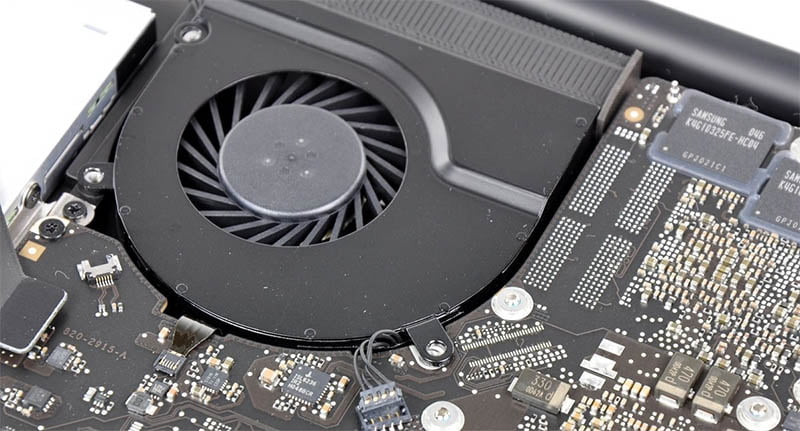How to fix MacBook loud fan noise? Apple designers are notorious for prioritising function over form. Despite their tiny and streamlined design, Macs provide adequate cooling performance. However, the MacBook fan occasionally makes a loud noise.
Table of Contents
How to fix MacBook fan noise?
A loud fan running for an extended period of time is an indication that something is wrong. We’ve compiled a list of the greatest methods to silence your Mac lover.

Why is my Mac fan so loud?
There are several causes for this. It could be malfunctioning hardware or another issue, such as limited airflow. When you do graphics-intensive applications like video editing, gaming, and so on, the fans usually start humming. Furthermore, if your Mac fan only turns on during hard tasks, there is no need to be concerned.
The issue arises when the Mac fan runs for an extended period of time. In some circumstances, the fan will not turn off even after the temperature has dropped.
List of Methods to fix MacBook fan noise?
The procedures below will assist you in determining the cause of the loud Mac fan.
Method 1: Check CPU usage through Activity Monitor
Chrome is known for consuming computational resources. Furthermore, a slew of open browser tabs exacerbates the issue. I recommend limiting multitasking. Most crucially, you may use graphics-intensive apps like Lightroom CS5 or Final Cut to close other apps.
Using Activity Monitor, identify apps that consume a lot of resources.
- Open Activity Monitor and navigate to the CPU Column.
- Examine the apps with the highest CPU consumption and close those you don’t require.
Hopefully, the fan noise should go away after a few minutes; if not, move on to the next step. Please keep in mind that machines run for a long time when Spotlights analyzes your hard drive.
Method 2: Insufficient Air Movement
When I had left my Mac in my car one beautiful afternoon. I was in for a harsh awakening when my MacBook Air refused to start and became as hot as fire.
I instantly moved it into the shade. After a while, the laptop began to work again. The machine apparently refused to start due to the high-temperature fail-safe feature.
Keep your Mac away from cushions, sofas, and other situations with poor air circulation. In the absence of external airflow, Mac tends to overheat. In addition, place your Mac on a sturdy surface or consider utilising a laptop stand.
Method 3: Average temperature should be within the operating capacity
The surface temperature, or exterior temperature, is quite important. Temperatures stipulated by international safety standards are met by Mac.
In terms of numbers, you should use Mac in environments where the ambient/external temperature ranges between 50° and 95°. Meanwhile, the humidity level should range between 0% and 95%. Consider air conditioning if you reside in an area with high temperatures.
Method 4: Inspect your Mac to see if it is overheating
The most likely cause of loud fan noise is overheating. Because Mac is overheating, the fan works hard to dissipate heat. On the other hand, the fan will run at high speeds for a longer period of time.
I recommend using free utilities such as CoconutBattery. It displays the internal temperature and alerts you if your Mac battery is overheated. Having said that, none of the instruments measures the temperature of the casing.
Method 5: Air vents that seem to be dirty
Vents are airways that serve to dissipate heat. By obstructing them, the temperature will rise, and your Mac will finally overheat. The vents are used to expel heated air. The location of the vents is determined by the model of your MacBook. The majority of Macs have an air hole near the monitor hinge.
The most recent M1-powered Macs include a passive cooling system. As a result, there are no fans or vents. You only need to restart M1 Mac.
Method 6: Fake Apple adaptor
Third-party power adapters may be inexpensive. However, in the long term, they cause more harm than good. Use a genuine Apple adapter or an MFI-certified accessory. Counterfeit adapters may cause overheating, motherboard damage, and faster battery depletion.
Method 7: Wouldn’t reset the SMC in a long time (For Intel-powered MacBook)
SMC is intended to manage low-level system functions. To remedy battery and fan difficulties, Apple recommends resetting the SMC (System Management Controller). Here’s how to reset the SMC on Intel-based Macs. The step does not apply to the M1 Mac because it has a passive cooling system.
Method 8: Scan your Mac for viruses and malware
Overheating is caused by some Mac viruses and spyware. To install a code, cryptojackers utilise trickery. Once completed, the code mines cryptocurrency using the hardware on your Mac. To put it another way, the spyware steals your CPU resources. Here’s how to remove Mac viruses and malware.
How to Fix a MacBook fan running so loud?
The preceding stages in this article assist in determining why the Mac fan is so loud. This section will discuss how to fix loud fan noise on a Mac.
Method 1: Control and inspect the cooling system manually to Fix MacBook Fan Noise
Method 2: Use Apple diagnostics to troubleshoot and Fix MacBook Fan Noise
Method 3: Inspect your MacBook by Apple Support Team
If the Mac problem does not fix, it could be a hardware issue. The best line of action would be to take it to an Apple service centre and get it checked out. You could also go to an Apple Independent Repair shop. Priority should be given to resolving the issue. Overheating and loud fans could cause serious damage to your Mac.
I hope the troubleshooting techniques assisted in resolving your Mac’s noisy fan. Do you have any other questions or want to contribute something? Leave your opinions in the comments section below.






One Comment